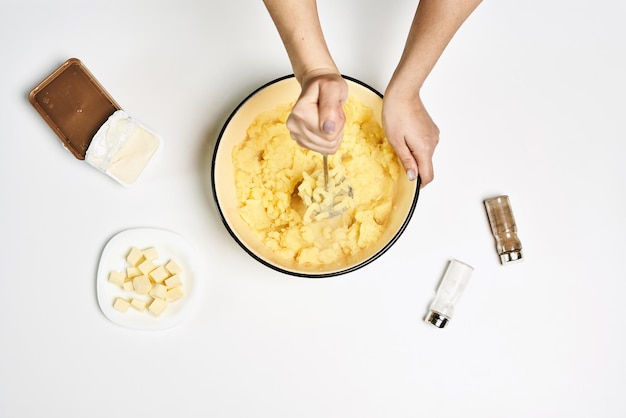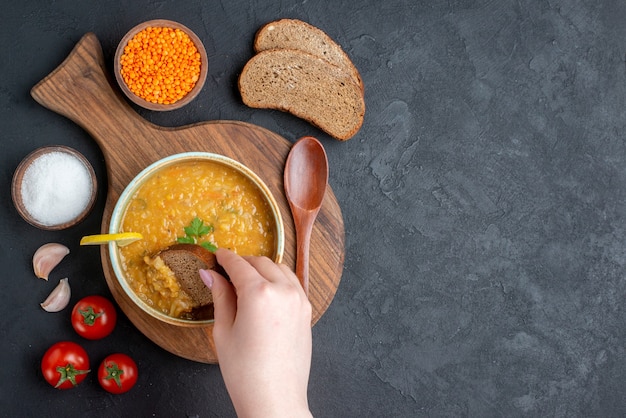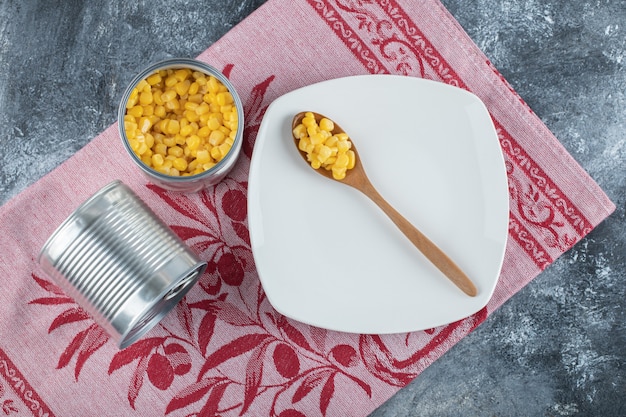There's something about a bowl of creamy polenta that just makes me feel warm and fuzzy inside. It's the kind of comfort food that reminds you of home, of family gatherings, of simple pleasures. And the best part? It's incredibly easy to make. I've been whipping up polenta for years now, experimenting with different flavors and textures, and I'm here to share my tried-and-true recipe with you. Grab your apron, gather your ingredients, and let's get cooking!
(Part 1) The Basics of Polenta: A Journey of Discovery

Polenta is, essentially, cornmeal cooked in water or broth. It's a staple in many Italian kitchens, and for good reason. It's so simple to make, yet incredibly versatile. You can serve it as a side dish, use it as a base for other dishes, or even enjoy it on its own. It's like a blank canvas, ready for your culinary creativity to shine through.
My First Bite of Polenta: A Culinary Revelation
My first encounter with polenta was at a little Italian restaurant in the heart of London. It was served alongside a hearty sausage stew, and I was immediately smitten. The polenta was smooth and creamy, with just a hint of sweetness, and it perfectly balanced the rich, savory flavors of the stew. It was a revelation. From that moment on, I knew I had to learn how to make this delicious dish at home.
Understanding the Different Types of Polenta
Not all polenta is created equal! There are a few different types of polenta available, each with its own unique texture and flavor:
- Fine Polenta: This is the most common type of polenta, perfect for creamy dishes. It's made with finely ground cornmeal, which results in a smooth and silky texture. Think of it as the classic polenta, the one you'd typically find in restaurants and cookbooks.
- Medium Polenta: This type has a slightly coarser texture than fine polenta, making it ideal for dishes where you want a bit more bite. It's often used in baked polenta recipes. Imagine it as the "in-between" polenta, offering a bit more texture and a rustic feel.
- Coarse Polenta: This is the least finely ground type of polenta, with a distinctly grainy texture. It's best used in dishes where you want a rustic flavor and texture, like polenta cakes or fritters. Think of it as the "chewy" polenta, perfect for those who like a bit more texture in their food.
(Part 2) My Favourite Polenta Recipe: A Simple Yet Exquisite Dish

This is the recipe I've perfected over the years, my go-to for a simple yet satisfying meal. It's so easy to make, even if you're a complete beginner in the kitchen, and it always turns out perfectly creamy and delicious.
Ingredients:
- 1 cup (240ml) water
- 1 cup (240ml) vegetable broth (I prefer a low-sodium broth for a lighter flavor)
- 1/2 teaspoon salt (adjust to your taste)
- 1/4 cup (50g) fine polenta (you can substitute medium polenta if you prefer a slightly coarser texture)
- 1 tablespoon butter (unsalted, for a more balanced flavor)
- Freshly grated Parmesan cheese (optional, but highly recommended!)
Instructions:
1. In a medium saucepan, combine the water, broth, and salt. Bring the mixture to a boil over medium heat. This is where the magic begins, so keep an eye on the pot and be ready to stir!
2. Slowly whisk in the polenta until it's completely incorporated. Reduce the heat to low and simmer for 5-7 minutes, stirring occasionally, until the polenta is thickened and creamy. Take your time with this step. The slower you whisk in the polenta, the smoother the texture will be.
3. Stir in the butter until it's melted and the polenta is smooth. This is the final touch, adding richness and a subtle creaminess to the dish.
4. Serve immediately, topped with freshly grated Parmesan cheese, if desired. Enjoy! This is the moment you've been waiting for, the moment to savor the deliciousness of your homemade polenta.
(Part 3) Tips and Tricks: Elevate Your Polenta Game

Now, let's talk about some tips and tricks to make your polenta even more delightful. It's about adding those little touches that make a world of difference, whether it's about the texture or the flavor.
Whisking Away Lumps: A Crucial Step
When you're whisking in the polenta, make sure to do it gradually and consistently. This will help prevent lumps from forming, and you'll end up with a silky smooth texture. Think of it as a gentle dance between you and the polenta. If you do get any lumps, don't worry! Just keep whisking, and they'll eventually disappear. It's all about patience and perseverance.
The Power of Simmering: Patience is Key
Simmering the polenta for 5-7 minutes is essential for developing its creamy texture. Don't be tempted to rush this step! The longer you simmer it, the smoother and richer the polenta will be. Just make sure to stir it occasionally to prevent it from sticking to the bottom of the pan. This is the time for the flavors to meld and the polenta to transform into something truly special.
Playing with Flavours: Unleashing Your Creativity
Polenta is a blank canvas, so don't be afraid to get creative with flavors. Here are a few ideas to spark your imagination:
- Herbs and Spices: Add a pinch of your favorite herbs or spices to the polenta while it's simmering. Think rosemary, thyme, oregano, garlic powder, or even a touch of chilli flakes for a kick. This is where you can add your personal touch, reflecting your own culinary preferences.
- Vegetables: Sauté some chopped vegetables, like mushrooms, onions, or bell peppers, and stir them into the polenta before serving. You can even blend in some roasted butternut squash or sweet potato for a creamy and decadent touch. Don't be afraid to experiment with different vegetables and textures.
- Cheese: Polenta loves cheese! Experiment with different types, like cheddar, mozzarella, or even goat cheese. You can also stir in some crumbled blue cheese for a more intense flavour. The possibilities are endless, allowing you to create unique and delicious flavor combinations.
(Part 4) Serving Suggestions: Endless Possibilities
The beauty of polenta is its versatility. You can serve it in countless ways, depending on your mood and culinary creativity. Here are just a few ideas to get you started:
Polenta as a Side Dish: The Perfect Complement
Polenta makes a fantastic side dish for a wide variety of main courses. It's perfect for:
- roast chicken or Turkey: The creamy texture of polenta perfectly complements the succulent meat of roast chicken or turkey. Imagine the combination of the savory flavors of the meat with the smooth, comforting texture of the polenta. It's a culinary symphony!
- grilled salmon or Steak: Polenta adds a touch of elegance to your grilled seafood or steak. You can even top it with a simple herb sauce for an extra touch of flavor. This is a great way to elevate a simple meal to a more sophisticated level.
- Hearty Stews or Chilis: Polenta is the ultimate comfort food when paired with a warm, hearty stew or chili. It's the perfect way to soak up all those delicious flavors. This is where polenta truly shines as a comfort food, offering a warm and satisfying experience.
Polenta as a Main Course: The Star of the Show
Polenta can also be the star of the show! Here are a few ideas for polenta-based main courses:
- Polenta Cakes: These are incredibly versatile and can be enjoyed for breakfast, lunch, or dinner. Simply mix your cooked polenta with some eggs, cheese, and your favourite herbs and spices, then fry them in a pan until golden brown. Imagine a crispy exterior giving way to a warm and cheesy center. It's a delightful combination!
- Baked Polenta: This is a delicious and easy way to enjoy polenta. Simply spread your cooked polenta in a baking dish, top it with your favourite ingredients, and bake until it's bubbly and golden brown. Some popular toppings include cheese, mushrooms, spinach, and tomatoes. This is a great way to showcase the versatility of polenta, as you can customize it to your liking.
- Polenta Fritters: These are a fun and tasty way to use up leftover polenta. Simply shape your cooked polenta into small patties, then fry them in a pan until golden brown and crispy. A perfect way to give new life to leftover polenta, transforming it into a delightful snack or appetizer.
(Part 5) Polenta in Different Cultures: A Global Journey
While polenta is often associated with Italian cuisine, it's actually enjoyed in many different cultures around the world. Each culture has its own unique twist on this versatile dish, reflecting the diverse culinary traditions and ingredients available in different regions.
Polenta in Italy: A Culinary Heritage
In Italy, polenta is a staple food, especially in the northern regions. It's often served as a side dish with meat, fish, or vegetables. One of the most popular ways to enjoy polenta in Italy is with "funghi porcini," a type of wild mushroom that adds a delicious earthy flavour. The Italians have a long history of using polenta in their cuisine, reflecting the rich culinary heritage of the region.
Polenta in Romania: A Hearty and Beloved Staple
In Romania, polenta is known as "m??m??lig??" and is a beloved staple food. It's typically served with cheese, sour cream, or various stews. The Romanians often use a type of coarse polenta that has a more grainy texture, which is perfect for soaking up all the flavours of the accompanying dishes. The Romanians have embraced polenta as a hearty and comforting food, reflecting the local culinary traditions.
Polenta in South Africa: A Versatile and Beloved Food
In South Africa, polenta is known as "pap" and is a popular food among both black and white communities. It's usually served with stews, meats, and vegetables. The South Africans often use a type of white maize meal to make their pap, which gives it a distinct creamy texture. The South Africans have incorporated polenta into their culinary landscape, showcasing its versatility and adaptability.
(Part 6) Polenta: More than Just a Dish
Polenta is more than just a delicious and versatile dish. It's a symbol of history, culture, and tradition. It's a reminder of the simple pleasures in life, the joy of sharing a meal with loved ones, and the warmth of a home-cooked meal.
A Culinary Heritage: The Story of Food
Polenta has been a staple food for centuries, and its history is deeply intertwined with the cultures and traditions of the regions where it's enjoyed. It's a reminder of the ingenuity of people who have found ways to use simple ingredients to create delicious and nourishing meals. Each culture has its own unique story to tell about polenta, reflecting the history and evolution of food and culinary practices.
A Symbol of Comfort: A Warm and Fuzzy Feeling
For many people, polenta evokes a sense of comfort and nostalgia. It's the kind of dish that warms the soul and brings back happy memories. It's a reminder of simple pleasures, the joy of a shared meal, and the importance of tradition. Polenta is a dish that transcends time and culture, offering a sense of comfort and connection.
A culinary journey: Exploring the World Through Food
Exploring different cultures and their unique takes on polenta can be a fascinating culinary journey. It allows you to experience the world through the lens of food, and to appreciate the diverse ways in which people use simple ingredients to create delicious and nourishing meals. It's a reminder that food is more than just sustenance; it's a way to connect with our heritage, our culture, and our sense of place in the world.
(Part 7) Mastering the Art of Polenta: A Journey of Experimentation
Making polenta is a journey of discovery, a process of experimentation and exploration. Don't be afraid to try new things, to experiment with different flavours and textures, and to create your own unique version of this versatile dish. The beauty of polenta is that it's a blank canvas, ready for your culinary creativity to shine through. So go ahead, unleash your inner chef, and see what culinary masterpieces you can create!
My Polenta Journey: A culinary adventure
My own journey with polenta has been filled with experimentation and discovery. I've learned that the key to making delicious polenta is to embrace the process, to be patient, and to have fun. I've tried countless variations, from classic creamy polenta to more adventurous flavours like truffle oil polenta or smoked paprika polenta. Each experiment has been a learning experience, and each success has been a delicious reward. The beauty of cooking is that there's always something new to learn, something new to try.
The Joy of Experimentation: Unleashing Creativity
Polenta is a great example of the joy of experimentation in cooking. It's a simple dish that can be transformed into a culinary masterpiece with a little bit of creativity and experimentation. So, the next time you make polenta, don't be afraid to step outside your comfort zone and try something new. The possibilities are endless, and the rewards are delicious.
(Part 8) FAQs: Your Polenta Questions Answered
Now, let's address some common questions you might have about polenta.
1. Can I Use Other Liquids?
Yes! While water and broth are the most common liquids for polenta, you can certainly experiment with others. You can use milk for a richer, creamier texture, or even try vegetable juice for a more intense flavour. Just remember to adjust the cooking time accordingly. The choice is yours!
2. How Long Can I Keep Cooked Polenta?
Cooked polenta can be stored in the refrigerator for up to 3 days. To reheat it, simply microwave it on low power until it's warmed through. You can also add a little bit of water or broth to the polenta before reheating to make it more creamy. So, if you're planning ahead, you can make a batch of polenta and enjoy it over several meals.
3. Can I Freeze Polenta?
Yes, you can freeze polenta. To freeze it, spread it in a single layer in a freezer-safe container or bag. Once frozen, you can break it into smaller pieces and store it in a freezer bag. To reheat frozen polenta, simply thaw it in the refrigerator overnight and then reheat it in a saucepan over low heat, adding a little bit of water or broth to make it more creamy. This is a great way to have a delicious and convenient meal ready whenever you need it.
4. What Can I Do with Leftover Polenta?
Leftover polenta is a great base for a variety of dishes. You can use it to make polenta cakes, fritters, or even soup. It's also a great addition to salads, sandwiches, and wraps. Get creative and see what culinary delights you can create with your leftover polenta! Don't let leftover polenta go to waste. There are countless possibilities for giving it new life.
5. Can I Make Polenta in a slow cooker?
Yes, you can make polenta in a slow cooker! Simply combine the water, broth, salt, and polenta in the slow cooker and cook on low heat for 4-6 hours. The polenta will slowly thicken and become creamy. This is a great option if you're looking for a hands-off method for making polenta. It's a perfect way to make polenta while you're busy with other things.
Conclusion: A Culinary Adventure Awaits
So there you have it – my love letter to polenta. It's a dish that's both comforting and versatile, and it's a testament to the creativity and ingenuity of culinary traditions around the world. So, go ahead, embrace the joy of cooking, and embark on your own polenta adventure! Who knows what culinary delights await you?
Everyone is watching

Corn on the Cob: The Ultimate Guide to Perfectly Cooked Ears
Healthy MealsAh, corn on the cob. Just the name evokes images of sunny days, barbecues, and that sweet, juicy flavour that ...

Perfect Pork Roast Oven Cooking Time: A Guide to Delicious Results
Healthy MealsThere's something truly satisfying about a perfectly roasted pork. The aroma alone is enough to make your mout...

Ham Cooking Time: How Long to Bake, Smoke, or Boil a Delicious Ham
Healthy MealsAh, ham. It's a classic, isn't it? A real crowd-pleaser, especially around holidays. And when done right, it'...

Scallops: The Ultimate Guide to Perfect Cooking
Healthy MealsAh, scallops. Those delicate, sweet, and utterly delicious morsels of the sea. They hold a special place in my...

Spaghetti Squash: The Ultimate Guide to Cooking and Serving
Healthy MealsRemember that time you saw spaghetti squash at the supermarket, looking all bumpy and strange, and thought, "W...
